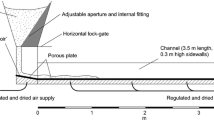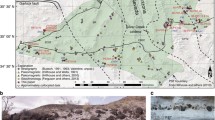Abstract
The depositional processes and gas pore pressure in pyroclastic flows are investigated through scaled experiments on transient, initially fluidized granular flows. The flow structure consists of a sliding head whose basal velocity decreases backwards from the front velocity (U f) until onset of deposition occurs, which marks transition to the flow body where the basal deposit grows continuously. The flows propagate in a fluid-inertial regime despite formation of the deposit. Their head generates underpressure proportional to U 2f whereas their body generates overpressure whose values suggest that pore pressure diffuses during emplacement. Complementary experiments on defluidizing static columns prove that the concept of pore pressure diffusion is relevant for gas-particle mixtures and allow characterization of the diffusion timescale (t d) as a function of the material properties. Initial material expansion increases the diffusion time compared with the nonexpanded state, suggesting that pore pressure is self-generated during compaction. Application to pyroclastic flows gives minimum diffusion timescales of seconds to tens of minutes, depending principally on the flow height and permeability. This study also helps to reconcile the concepts of en masse and progressive deposition of pyroclastic flow units or discrete pulses. Onset of deposition, whose causes deserve further investigation, is the most critical parameter for determining the structure of the deposits. Even if sedimentation is fundamentally continuous, it is proposed that late onset of deposition and rapid aggradation in relatively thin flows can generate deposits that are almost snapshots of the flow structure. In this context, deposition can be considered as occurring en masse, though not strictly instantaneously.












Similar content being viewed by others
References
Andrews B, Manga M (2012) Experimental study of turbulence, sedimentation, and coignimbrite mass partitioning in dilute pyroclastic density currents. J Volcanol Geotherm Res 225–226:30–44. doi:10.1016/j.jvolgeores.2012.02.011
Branney MJ, Kokelaar P (1992) A reappraisal of ignimbrite emplacement: progressive aggradation and changes from particulate to non-particulate flow during emplacement of high-grade ignimbrite. Bull Volcanol 54:504–520
Carslaw HS, Jaeger JC (1959) Conduction of heat in solids, 2nd edn. Oxford University Press, New York
Cas RAF, Wright HMN, Folkes CB, Lesti C, Porreca M, Giordano G, Viramonte JG (2011) The flow dynamics of an extremely large volume pyroclastic flow, the 2.08-Ma Cerro Galán Ignimbrite, NW Argentina, and comparison with other flow types. Bull Volcanol 73:1583–1609. doi:10.1007/s00445-011-0564-y
Charbonnier SJ, Gertisser R (2009) Numerical simulations of block-and-ash flows using the Titan2D flow model: examples from the 2006 eruption of Merapi volcano, Java, Indonesia. Bull Volcanol 71:953–959. doi:10.1007/s00445-009-0299-1
Denlinger RP, Iverson RM (2001) Flow of variably fluidized granular masses across three-dimensional terrain 2. Numerical predictions and experimental tests. J Geophys Res 106:553–566
Doyle EE, Hogg AJ, Mader HM, Sparks RSJ (2010) A two-layer model for the evolution and propagation of dense and dilute regions of pyroclastic currents. J Volcanol Geotherm Res 190:365–378. doi:10.1016/j.jvolgeores.2009.12.004
Druitt TH (1998) Pyroclastic density currents. In: Gilbert JS, Sparks RSJ (eds) The physics of explosive volcanic eruptions. Geol Soc London Spec Pub 145: 145–182.
Druitt TH, Sparks RSJ (1982) A proximal ignimbrite breccias facies on Santorini, Greece. J Volcanol Geotherm Res 13:147–171
Druitt TH, Avard G, Bruni G, Lettieri P, Maez F (2007) Gas retention in fine-grained pyroclastic flow materials at high temperatures. Bull Volcanol 69:881–901
Dufek J, Manga M (2008) In situ production of ash in pyroclastic flows. J Geophys Res 113:B09207. doi:10.1029/2007JB005555
Fisher RV (1966) Mechanism of deposition from pyroclastic flows. Am J Sci 264:350–363
Freundt A, Carey S, Wilson CJN (2000) Ignimbrites and block-and-ash flow deposits. In: Sigurdsson H et al (eds) Encyclopedia of volcanoes. Academic Press, NY-London, pp 581–600
Geldart D (1986) Gas fluidization technology. Wiley, New York
Girolami L, Druitt TH, Roche O, Khrabrykh Z (2008) Propagation and hindered settling of laboratory ash flows. J Geophys Res 113:B02202. doi:10.1029/2007JB005074
Girolami L, Roche O, Druitt TH, Corpetti T (2010) Velocity fields and depositional processes in laboratory ash flows. Bull Volcanol 72:747–759. doi:10.1007/s00445-010-0356-9
Goren L, Aharonov E, Sparks D, Toussaint R (2010) Pore pressure evolution in deforming granular material: a general formulation and the infinitely stiff approximation. J Geophys Res 115:B09216. doi:10.1029/2009JB007191
Gröbelbauer HP, Fannelop TK, Britter RE (1993) The propagation of intrusion fronts of high density ratios. J Fluid Mech 250:669–687
Hoblitt RP (1986) Observations of the eruptions of July 22 and August 7, 1980, at Mount St. Helens, Washington. US Geol Surv Prof Pap 1334:44
Iverson RM (1997) The physics of debris flows. Rev Geophys 35:245–296
Iverson RM, Denlinger RP (2001) Flow of variably fluidized granular masses across three-dimensional terrain 1. Coulomb mixture theory. J Geophys Res 106:537–552
Kelfoun K, Samaniego P, Palacios P, Barba D (2009) Testing the suitability of frictional behaviour for pyroclastic flow simulation by comparison with a well-constrained eruption at Tungurahua volcano (Ecuador). Bull Volcanol 71:1057–1075. doi:10.1007/s00445-009-0286-6
Levine AH, Kieffer SW (1991) Hydraulics of the August 7, 1980, pyroclastic flow at Mount St. Helens, Washington. Geology 19:1121–1124
Lube G, Cronin SJ, Platz T, Freundt A, Procter JN, Henderson C, Sheridan MF (2007a) Flow and deposition of pyroclastic granular flows: a type example from the 1975 Ngauruhoe eruption, New Zealand. J Volcanol Geotherm Res 161:165–186
Lube G, Huppert HE, Sparks RSJ, Freundt A (2007b) Static and flowing regions in granular collapses down channels. Phys Fluids 19:043301. doi:10.1063/1.2712431
Lube G, Huppert HE, Sparks RSJ, Freundt A (2011) Granular column collapses down rough, inclined channels. J Fluid Mech 675:347–368. doi:10.1017/jfm.2011.21
Major JJ, Iverson RM (1999) Debris-flow deposition: effects of pore-fluid pressure and friction concentrated at flow margins. Geol Soc Am Bull 111:1424–1434
Manga M, Patel A, Dufek J (2011) Rounding of pumice clasts during transport: field measurements and laboratory studies. Bull Volcanol 73:321–333. doi:10.1007/s00445-010-0411-6
McElwaine J, Nishimura K (2001) **-pong ball avalanche experiments. Special Publications of the International Association of Sedimentology 31:135–148
McElwaine JN (2005) Rotational flow in gravity current heads. Philosophical Transactions of the Royal Society (A) 363:1603-1623. doi:1610.1098/rsta.2005.1597
McElwaine JN, Turnbull B (2005) Air pressure data from the Vallée de la Sionne avalanches of 2004. J Geophys Res 110:F03010. doi:03010.01029/02004JF000237
Montserrat S, Tamburrino A, Roche O, Niño Y (2012). Pore fluid pressure diffusion in defluidizing granular columns. J Geophys Res 117:F02034. doi:10.1029/2011JF002164
Roche O, Gilbertson MA, Phillips JC, Sparks RSJ (2004) Experimental study of gas-fluidized granular flows with implications for pyroclastic flow emplacement. J Geophys Res 109:B10201
Roche O, Gilbertson MA, Phillips JC, Sparks RSJ (2005) Inviscid behaviour of fines-rich pyroclastic flows inferred from experiments on gas-particle mixtures. Earth Planet Sci Lett 240:401–414. doi:10.1016/j.epsl.2005.09.053
Roche O, Montserrat S, Niño Y, Tamburrino A (2008) Experimental observations of water-like behavior of initially fluidized, dam break granular flows and their relevance for the propagation of ash-rich pyroclastic flows. J Geophys Res 113:B12203. doi:10.1029/2008JB005664
Roche O, Montserrat S, Niño Y, Tamburrino A (2010) Pore fluid pressure and internal kinematics of gravitational laboratory air-particle flows: insights into the emplacement dynamics of pyroclastic flows. J Geophys Res 115:B09206. doi:10.1029/2009JB007133
Savage SB, Hutter K (1991) The dynamics of avalanches of granular materials from initiation to runout. Part I: Analysis Acta Mech 86:201–223
Simpson JE (1997) Gravity currents in the environment and the laboratory. Cambridge University Press, Cambridge
Sparks RSJ (1976) Grain size variations in ignimbrites and implications for the transport of pyroclastic flows. Sedimentology 23:147–188
Sparks RSJ, Self S, Walker GPL (1973) Products of ignimbrites eruptions. Geology 1:115–118
Sulpizio R, Dellino P (2008) Sedimentology, depositional mechanisms and pulsating behaviour of pyroclastic density currents. In: Gottsmann J, Martí J. (eds) Caldera volcanism. Analysis, modelling, and response. Development in volcanology 10. Elsevier, Amsterdam, pp 57–96.
Turnbull B, McElwaine J (2008) Experiments on the non-Boussinesq flow of self-igniting suspension currents on a steep open slope. J Geophys Res 113:F01003. doi:01010.01029/02007JF000753
Wilson CJN (1980) The role of fluidization in the emplacement of pyroclastic flows: an experimental approach. J Volcanol Geotherm Res 8:231–249
Wilson L, Head JW (1981) Morphology and rheology of pyroclastic flows and their deposits, and guidelines for future observations. In: Lipman PW, Mullineaux DR (eds) The 1980 eruptions of Mount St Helens, Washington. US Geol Surv Prof Paper 1250: 513–524.
Wilson CJN, Hildreth W (2003) Assembling an ignimbrite: mechanical and thermal building blocks in the Bishop tuff, California. J Geol 111:653–670
Acknowledgments
This work was supported by the Institut de Recherche pour le Développement (IRD, France), and the ANR Volbiflo (France) and ECOS-Conicyt C06U01 and C11U01 (France-Chile) projects. This is Laboratory of Excellence ClerVolc contribution n° 25. The paper benefited from useful reviews of Editor J. White, AE M. Manga, D. Doronzo, and an anonymous reviewer.
Author information
Authors and Affiliations
Corresponding author
Additional information
Editorial responsibility: M. Manga
Electronic supplementary material
Below is the link to the electronic supplementary material.
Proximal detail view of a flow generated from the release of a fluidized column of fine (d = 80 μm) glass beads and containing black markers (colored beads, d = 700 μm). The movie is ten times slower than actual and shows the sliding flow head and the aggrading basal deposit in the flow body. The basal horizontal plate is 1-cm thick. (AVI 18,906 kb)
ESM 2
Distal detail view of a flow generated from the release of a fluidized column of fine (d = 80 μm) glass beads and containing black markers (colored beads, d = 700 μm). The movie is ten times slower than actual, and shows the sliding flow head and the aggrading basal deposit in the flow body. The basal horizontal plate is 1-cm thick. (AVI 8,355 kb)
ESM 3
Flow generated from the release of a fluidized column (20 × 20 cm) of fine (d = 80 μm) glass beads and containing black PVC markers (d = 1–2 mm). The movie is ten times slower than actual. (AVI 29,010 kb)
ESM 4
Flow generated from the release of a dry column (20 × 20 cm) of fine (d = 80 μm) glass beads and containing black PVC markers (d = 1–2 mm). The movie is ten times slower than actual. (AVI 32,477 kb)
ESM 5
Detail view of a flow generated from the release of a fluidized column of fine (d = 80 μm) glass beads and containing black markers (colored beads, d = 700 μm), showing a subtle caterpillar-type motion at the flow front. The movie is fifty times slower than actual. (AVI 12,992 kb)
Rights and permissions
About this article
Cite this article
Roche, O. Depositional processes and gas pore pressure in pyroclastic flows: an experimental perspective. Bull Volcanol 74, 1807–1820 (2012). https://doi.org/10.1007/s00445-012-0639-4
Received:
Accepted:
Published:
Issue Date:
DOI: https://doi.org/10.1007/s00445-012-0639-4




